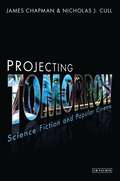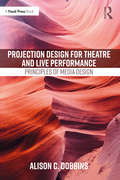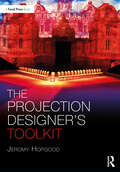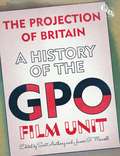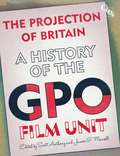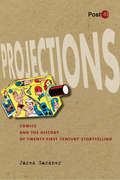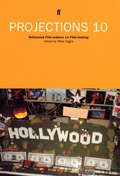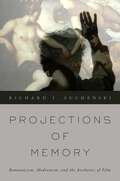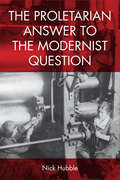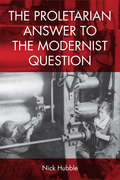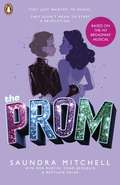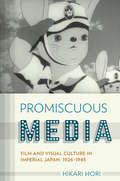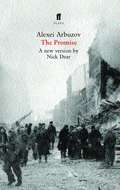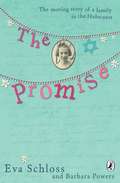- Table View
- List View
Projecting Tomorrow: Science Fiction and Popular Cinema (Cinema and Society)
by James Chapman Nicholas J. CullCinema and science fiction were made for each other. The science fiction genre has produced some of the most extraordinary films ever made, yet science fiction cinema is about more than just special effects. It has also provided a vehicle for filmmakers and writers to comment on their own societies and cultures. This new exploration of the genre examines landmark science fiction films from the 1930s to the present. They include genre classics such as Things to Come, Forbidden Planet and 2001: A Space Odyssey alongside modern blockbusters Star Wars and Avatar. Chapman and Cull consider both screen originals and adaptations of the work of major science fiction authors. They also range widely across the genre from pulp adventure and space opera to political allegory and speculative documentary – there is even a science fiction musical. Informed throughout by extensive research in US and British archives, the book documents the production histories of each film to show how they made their way to the screen – and why they turned out the way they did.
Projection Design for Theatre and Live Performance: Principles of Media Design
by Alison C. DobbinsProjection Design for Theatre and Live Performance explores the design and creation process of projections from a non-technical perspective, examining the principles of media for the stage in a manner that is accessible for both beginning designers and advanced designers dabbling in projections for the first time. This introductory text covers concepts and tools for designing, techniques to help readers tap into their creativity, and the core skills required of this field: problem solving, project management, and effective communication. Focusing exclusively on design and creativity, this book encourages individuals to leap into the creative design process before facing any perceived hurdles of learning everything technical about media delivery systems, cueing systems, projectors, cables, computer graphics, animation, and video production. Projection Design for Theatre and Live Performance is a reminder that, from the invention of photography to the enormous variety of electronic media that exist today, the ways projection designers can enhance a theatrical production are limitless. Written in an accessible style, this book is a valuable resource for students of Projection Design as well as emerging professionals. Its focus on design and creativity will restore the confidence of individuals who may have been daunted by technical hurdles and will encourage the creativity of those who may have been disappointed with their efforts in this field of design in the past.
Projection Design for Theatre and Live Performance: Principles of Media Design
by Alison C. DobbinsProjection Design for Theatre and Live Performance explores the design and creation process of projections from a non-technical perspective, examining the principles of media for the stage in a manner that is accessible for both beginning designers and advanced designers dabbling in projections for the first time. This introductory text covers concepts and tools for designing, techniques to help readers tap into their creativity, and the core skills required of this field: problem solving, project management, and effective communication. Focusing exclusively on design and creativity, this book encourages individuals to leap into the creative design process before facing any perceived hurdles of learning everything technical about media delivery systems, cueing systems, projectors, cables, computer graphics, animation, and video production. Projection Design for Theatre and Live Performance is a reminder that, from the invention of photography to the enormous variety of electronic media that exist today, the ways projection designers can enhance a theatrical production are limitless. Written in an accessible style, this book is a valuable resource for students of Projection Design as well as emerging professionals. Its focus on design and creativity will restore the confidence of individuals who may have been daunted by technical hurdles and will encourage the creativity of those who may have been disappointed with their efforts in this field of design in the past.
The Projection Designer’s Toolkit (The Focal Press Toolkit Series)
by Jeromy HopgoodThe Projection Designer’s Toolkit is an insider’s guide to the world of professional projection design, serving as a reference for the planning and execution of each step in the projection design process. The text addresses the design process within the context of a professional projection designer’s workflow, focusing on specific tools of the trade, best practices for communicating your design to collaborators, tips and tricks, determining budget, working with assistants, and more. Featuring interviews with some of the top names in the industry, the book offers an unprecedented insight into the professional projection designer’s process across a wide range of fields, from Broadway and regional theatre to corporate design and music touring. The book also includes in-depth discussion on production process, system design, cue and content planning, content design, digital media fundamentals, media servers, video equipment, and projection surfaces. Additionally, it features hundreds of full-color photos and examples of designer artifacts such as draftings, mock-ups, paperwork, cue sheets, and renderings. Filled with practical advice that will guide readers from landing their first job all the way through opening night and beyond, The Projection Designer’s Toolkit is the perfect resource for emerging projection designers and students in Digital Media Design and Projection Design courses.
The Projection Designer’s Toolkit (The Focal Press Toolkit Series)
by Jeromy HopgoodThe Projection Designer’s Toolkit is an insider’s guide to the world of professional projection design, serving as a reference for the planning and execution of each step in the projection design process. The text addresses the design process within the context of a professional projection designer’s workflow, focusing on specific tools of the trade, best practices for communicating your design to collaborators, tips and tricks, determining budget, working with assistants, and more. Featuring interviews with some of the top names in the industry, the book offers an unprecedented insight into the professional projection designer’s process across a wide range of fields, from Broadway and regional theatre to corporate design and music touring. The book also includes in-depth discussion on production process, system design, cue and content planning, content design, digital media fundamentals, media servers, video equipment, and projection surfaces. Additionally, it features hundreds of full-color photos and examples of designer artifacts such as draftings, mock-ups, paperwork, cue sheets, and renderings. Filled with practical advice that will guide readers from landing their first job all the way through opening night and beyond, The Projection Designer’s Toolkit is the perfect resource for emerging projection designers and students in Digital Media Design and Projection Design courses.
The Projection of Britain: A History of the GPO Film Unit
by Scott Anthony & James G. MansellThe General Post Office (GPO) Film Unit sat at the creative epicentre of Britain in the 1930s. It nurtured a vital crop of artistic talent, built a forum for a new kind of cinematic address and created Britain's first self-consciously national cinema. In 2011, UNESCO added its work to the UK Memory of the World Register, recognising its status as part of Britain's cultural heritage. Elements of the GPO Film Unit's story are well known: John Grierson's development of documentary cinema; the influence of Mass Observation and Surrealism on its cinematic vision; the Watt–Auden–Britten collaboration Night Mail. The Projection of Britain: A History of the GPO Film Unit brings together primary materials and critical appraisals to revisit, re-contextualise and revitalise these seminal moments in British cinema. Here, the insights of an archivist, a musicologist, a design historian, a sports historian, a geographer and a postman – among others – have been edited into a rich critical archaeology of a compelling moment in cinematic history. Interspersed with these essays are primary materials – memoirs, magazine articles, posters and government documents – that detail everything from Alberto Cavalcanti's vision for the documentary movement to a claim for the clothes Humphrey Jennings lost while shooting on location. In recent years there has been a resurgence of interest in the GPO Film Unit and its work, on the big screen, in DVD boxsets and on the web. The Projection of Britain ties together the Unit's diverse artistic, historical and cultural threads into an essential one-stop resource. Provocative, imaginative and ambitious, this expansive study is the definitive companion to an extraordinary episode in cinematic history.
The Projection of Britain: A History of the GPO Film Unit
The General Post Office (GPO) Film Unit sat at the creative epicentre of Britain in the 1930s. It nurtured a vital crop of artistic talent, built a forum for a new kind of cinematic address and created Britain's first self-consciously national cinema. In 2011, UNESCO added its work to the UK Memory of the World Register, recognising its status as part of Britain's cultural heritage. Elements of the GPO Film Unit's story are well known: John Grierson's development of documentary cinema; the influence of Mass Observation and Surrealism on its cinematic vision; the Watt–Auden–Britten collaboration Night Mail. The Projection of Britain: A History of the GPO Film Unit brings together primary materials and critical appraisals to revisit, re-contextualise and revitalise these seminal moments in British cinema. Here, the insights of an archivist, a musicologist, a design historian, a sports historian, a geographer and a postman – among others – have been edited into a rich critical archaeology of a compelling moment in cinematic history. Interspersed with these essays are primary materials – memoirs, magazine articles, posters and government documents – that detail everything from Alberto Cavalcanti's vision for the documentary movement to a claim for the clothes Humphrey Jennings lost while shooting on location. In recent years there has been a resurgence of interest in the GPO Film Unit and its work, on the big screen, in DVD boxsets and on the web. The Projection of Britain ties together the Unit's diverse artistic, historical and cultural threads into an essential one-stop resource. Provocative, imaginative and ambitious, this expansive study is the definitive companion to an extraordinary episode in cinematic history.
The Projection of Britain: A History of the GPO Film Unit
by James MansellThe General Post Office (GPO) Film Unit sat at the creative epicentre of Britain in the 1930s. It nurtured a vital crop of artistic talent, built a forum for a new kind of cinematic address and created Britain's first self-consciously national cinema. In 2011, UNESCO added its work to the UK Memory of the World Register, recognising its status as part of Britain's cultural heritage. Elements of the GPO Film Unit's story are well known: John Grierson's development of documentary cinema; the influence of Mass Observation and Surrealism on its cinematic vision; the Watt–Auden–Britten collaboration Night Mail. The Projection of Britain: A History of the GPO Film Unit brings together primary materials and critical appraisals to revisit, re-contextualise and revitalise these seminal moments in British cinema. Here, the insights of an archivist, a musicologist, a design historian, a sports historian, a geographer and a postman – among others – have been edited into a rich critical archaeology of a compelling moment in cinematic history. Interspersed with these essays are primary materials – memoirs, magazine articles, posters and government documents – that detail everything from Alberto Cavalcanti's vision for the documentary movement to a claim for the clothes Humphrey Jennings lost while shooting on location. In recent years there has been a resurgence of interest in the GPO Film Unit and its work, on the big screen, in DVD boxsets and on the web. The Projection of Britain ties together the Unit's diverse artistic, historical and cultural threads into an essential one-stop resource. Provocative, imaginative and ambitious, this expansive study is the definitive companion to an extraordinary episode in cinematic history.
Projections: Comics and the History of Twenty-First-Century Storytelling (Post*45 #21)
by Jared GardnerWhen Art Spiegelman's Maus won the Pulitzer Prize in 1992, it marked a new era for comics. Comics are now taken seriously by the same academic and cultural institutions that long dismissed the form. And the visibility of comics continues to increase, with alternative cartoonists now published by major presses and more comics-based films arriving on the screen each year. Projections argues that the seemingly sudden visibility of comics is no accident. Beginning with the parallel development of narrative comics at the turn of the 20th century, comics have long been a form that invites—indeed requires—readers to help shape the stories being told. Today, with the rise of interactive media, the creative techniques and the reading practices comics have been experimenting with for a century are now in universal demand. Recounting the history of comics from the nineteenth-century rise of sequential comics to the newspaper strip, through comic books and underground comix, to the graphic novel and webcomics, Gardner shows why they offer the best models for rethinking storytelling in the twenty-first century. In the process, he reminds us of some beloved characters from our past and present, including Happy Hooligan, Krazy Kat, Crypt Keeper, and Mr. Natural.
Projections 10: Hollywood Film-makers On Film-making
by Mike FiggisMike Figgis has always been intrigued by the workings of the Hollywood System. As he progressed from his acclaimed US debut Internal Affairs, through hellish studio wrangles on Mr. Jones, to Oscar-laurelled success with Leaving Las Vegas, Figgis always wanted to find a way to document the mores of the Hollywood industry, before it could swallow him whole. For Projections, he accepted an invitation to return to LA in late 1998 and create just such a document. In conversation with established players such as Mel Gibson, Jodie Foster and Jerry Bruckheimer, plus ascending talents such as Salma Hayek and Paul Thomas Anderson, Figgis paints a refreshingly honest but unmistakably dark portrait of an industry where money does more than talk.Mike Figgis's witnesses include Mel Gibson, Jodie Foster, Mickey Rourke, Nastassja Kinski, Elizabeth Shue, Salma Hayek, Paul Thomas Anderson, Jerry Bruckheimer and many more . . .
Projections of Memory: Romanticism, Modernism, and the Aesthetics of Film
by Richard I. SuchenskiProjections of Memory is an exploration of a body of innovative cinematic works that utilize their extraordinary scope to construct monuments to the imagination that promise profound transformations of vision, selfhood, and experience. This form of cinema acts as a nexus through which currents from the other arts can interpenetrate. By examining the strategies of these projects in relation to one another and to the larger historical forces that shape them--tracing the shifts and permutations of their forms and aspirations--Projections of Memory remaps film history around some of its most ambitious achievements and helps to clarify the stakes of cinema as a twentieth-century art form.
Projections of Memory: Romanticism, Modernism, and the Aesthetics of Film
by Richard I. SuchenskiProjections of Memory is an exploration of a body of innovative cinematic works that utilize their extraordinary scope to construct monuments to the imagination that promise profound transformations of vision, selfhood, and experience. This form of cinema acts as a nexus through which currents from the other arts can interpenetrate. By examining the strategies of these projects in relation to one another and to the larger historical forces that shape them--tracing the shifts and permutations of their forms and aspirations--Projections of Memory remaps film history around some of its most ambitious achievements and helps to clarify the stakes of cinema as a twentieth-century art form.
Projektmanagement im Hochbau: mit BIM und Lean Management
by Hans SommerDie erfolgreiche Abwicklung von Großprojekten braucht heute mehr denn je ein professionelles Projektmanagement. Dabei wird das digitale Planen und Bauen in Verbindung mit den Methoden des Lean Managements auf der Arbeitsebene die Zukunft maßgeblich bestimmen.Dieses Buch beschreibt praxisbezogen und aufbauend auf über 45 Jahren Erfahrung im Projektmanagement die wesentlichen Inhalte des Planungs- und Bauprozesses sowie die Aufgaben des Projektmanagers, seine Methoden und Werkzeuge. Es erläutert, wie die Projektabwicklung transparent und effektiv gestaltet werden kann, um für die Bauherrn das Optimum aus Nutzbarkeit, Gestaltung, Nachhaltigkeit und Wirtschaftlichkeit bei festen Kosten und Terminen sicherzustellen.Damit wendet sich das Buch an Projektmanager, Projektentwickler und Baufachleute, aber auch an die verantwortlichen Vertreter der Bauherren und Investoren, die erkannt haben, dass nachhaltiges und wirtschaftliches Bauen Zukunftsthemen in der Bau- und Immobilienwirtschaft sein werden.
Projektmanagement von Verkehrsinfrastrukturprojekten (VDI-Buch)
by Konrad SpangDieses von Fachexperten geschriebene Werk umfasst alle wesentlichen Schritte und Elemente des Projektmanagements von Straßen- und Eisenbahnprojekten und füllt damit eine seit langem offene Literaturlücke für die Praxis. Behandelt werden alle Prozesse der Planung, der Erarbeitung des Baurechts mit der Einbeziehung des Umfelds, der Organisation der Finanzierung, der Bauvorbereitung und der Baudurchführung aus Sicht der Bauherren und ihrer Planer. Wesentliche Elemente sind u.a. Projektcontrolling, Risikomanagement, Termin- und Kostenplanung, Stakeholdermanagement, Planrechtsverfahren, Ausschreibung und Vergabe. Verkehrsinfrastruktur hat eine zentrale Bedeutung für das Funktionieren einer Gesellschaft und für die Entwicklung der Wirtschaft. Kenntnisse über Planung und Realisierung von Verkehrswegen (Straßen und Schienenwege) werden im Hinblick auf die technischen und baubetrieblichen Aspekte an den Universitäten und Fachhochschulen vermittelt. Die berufstätigen Ingenieure haben dort ihr Fachwissen erworben. Mit diesem Werk liegt nun für die Praktiker ein Handbuch und ein Leitfaden für alle wesentlichen Prozesse in der Projektabwicklung (also von der Idee bis zur Inbetriebnahme) vor.
The Proletarian Answer to the Modernist Question
by Nick HubbleAnalyses what makes an acting performance excellent, through a range of examples from world cinema
The Proletarian Answer to the Modernist Question
by Nick HubbleWhat do we remember about US Presidents, and how do we come to commemorate their legacies?
The Prom: A Novel Based On The Hit Broadway Musical
by Saundra Mitchell Bob Martin Chad Beguelin Matthew SklarThey just wanted to dance. They didn't mean to start a revolution...The novel of the laugh-out-loud high school musical coming to Netflix in 2020, starring Meryl Streep, James Corden and Nicole Kidman.Emma knows better than anyone that Edgewater, Indiana, is not a great place to be gay. But she's had enough of high school homophobia and really wants to take her girlfriend - the popular, closeted It Girl Alyssa- to prom. How big a deal could that really be? But when their classmates find out, the backlash exceeds Emma's worst nightmares.Meanwhile, in Manhattan, Barry and Dee Dee are Broadway stars of yesteryear. When their new show bombs, they need some good publicity - fast. So when they happen to hear about Emma's plight, they decide to step in and create a prom for everyone.Suddenly, Edgewater is the centre of a national news story. As the drama queens of New York take over the sleepy town, chaos ensues and the glare of the spotlight is brighter than anyone could have guessed.But all Emma and Alyssa want is to dance together. Is that too much to ask?The perfect read for fans of Mean Girls and Dear Evan Hansen!
Promiscuous Grace: Imagining Beauty and Holiness with Saint Mary of Egypt (Class 200: New Studies in Religion)
by Sonia VelázquezA meditation on holiness and beauty through the study of Saint Mary of Egypt. Saint Mary of Egypt has fascinated theologians, poets, and artists since the seventh century. Her story is richly evocative, encompassing sin and sanctity, concupiscence and asceticism, youth and old age. In Promiscuous Grace, Sonia Velázquez thinks with Saint Mary of Egypt about the relationship between beauty and holiness. Drawing on an archive spanning Spanish medieval poetry, Baroque paintings, seventeenth-century hagiography, and Balzac’s Le chef-d’œuvre inconnu, Velázquez argues for the importance of the senses on the surface of religious texts on her way to revealing why the legend of Saint Mary of Egypt still matters today.
Promiscuous Media: Film and Visual Culture in Imperial Japan, 1926-1945 (Studies of the Weatherhead East Asian Institute, Columbia University)
by Hikari HoriIn Promiscuous Media, Hikari Hori makes a compelling case that the visual culture of Showa-era Japan articulated urgent issues of modernity rather than serving as a simple expression of nationalism. Hori makes clear that the Japanese cinema of the time was in fact almost wholly built on a foundation of Russian and British film theory as well as American film genres and techniques. Hori provides a range of examples that illustrate how maternal melodrama and animated features, akin to those popularized by Disney, were adopted wholesale by Japanese filmmakers.Emperor Hirohito's image, Hori argues, was inseparable from the development of mass media; he was the first emperor whose public appearances were covered by media ranging from postcards to radio broadcasts. Worship of the emperor through viewing his image, Hori shows, taught the Japanese people how to look at images and primed their enjoyment of early animation and documentary films alike. Promiscuous Media links the political and the cultural closely in a way that illuminates the nature of twentieth-century Japanese society.
The Promise
by Ben BrownIt's the beginning of World War I and Herbert Samuel - the first practicing Jew ever to sit in a British Cabinet - dreams of using British power to back a return of the Jews to Palestine after 1800 years. However, his cousin, Edwin Montagu - also in the Cabinet - is implacably opposed to the idea, a conflict complicated by Montagu's passion for the beautiful aristocrat, Venetia Stanley, a confidante of the Prime Minister, Herbert Asquith.Politics, religion and love collide with world-changing effect in this new play of political and sexual intrigue, and the origins of Israel.The Promise premiered at the Orange Tree Theatre in February 2010.
The Promise
by Nick DearIn the savage 1942 winter siege of Leningrad, as the Russians fight off the Nazi invaders, three teenagers - Lika, Marat and Leondik - are thrown together. Losing everything from their past, they forge a new love that binds them and a new hope which keeps them alive: the promise of a better future.Arbuzov's classic of the 1960s is revived here in Nick Dear's stunning adaptation for the Tricycle Theatre, London in 2002.
The Promise: The Moving Story of a Family in the Holocaust
by Barbara PowersThis is the remarkable true story of a young Jewish girl and her brother growing up during the Second World War, caught in a world turned upside down by the Nazis. Written specially for children, Eva describes her happy early childhood in Vienna with her kind and loving parents and her older brother Heinz, whom she adored. But when the Nazis marched into Austria everything changed. Eva's family fled to Belgium, then to Amsterdam where, with the help of the Dutch Resistance, they spent the next two years in hiding - Eva and her mother in one house, and her father and brother in another. Finally, though, they were all betrayed and deported to Auschwitz concentration camp in Poland. Despite the horrors of the camp, Eva's positive attitude and stubborn personality (which had often got her into trouble) saw her through one of the most tragic events in history and she and her mother eventually returned to Amsterdam. Sadly her father and brother perished just weeks before the liberation. Eva and her mother went back to the house where Heinz and his father had hidden, for Eva had remembered that Heinz had told her he had hidden his paintings beneath the floorboards there. Sure enough, there were over thirty beautiful paintings. Heinz hadn't wasted any of his talents during his captivity. For Eva, here was a tangible, everlasting memory of her brother and a reminder of her father's promise that all the good things you accomplish will make a difference to someone, and your achievements will be carried on. Heinz's paintings have been on display in exhibitions in the USA and are now a part of a permanent exhibition in Amsterdam's war museum. Told simply and clearly for younger readers, THE PROMISE is an unforgettable story, written by Eva Schloss, the step-daughter of Otto Frank and Barbara Powers, Eva's very close friend.
The Promise of Planning: Global Aspirations and South African Experience Since 2008 (ISSN)
by Alison Todes Philip HarrisonThe Promise of Planning explores the experience of planning internationally since the global financial crisis, focusing on South Africa. The book is a response to a decade-plus in which state-led planning has re-emerged as a putative means for achieving developmental goals (as indicated in global initiatives such as the New Urban Agenda) and where planning in South Africa has consolidated in terms of its legal and policy basis. However, the return of planning is happening in an inauspicious context, with economic fragilities, technological shifts, political populism, institutional complexities, and more, threatening to upturn the "new promise of planning." The book provides a careful analytical account of planning in South Africa and how and why its promises have been difficult to achieve. Building on the authors’ previous book, Planning and Transformation, the book sheds light on planning as an increasingly complex and diverse governmental practice within a perpetually changing world. It can be used as a resource for planners who must make good on the new promise of planning while navigating the risks and threats of the contemporary world, as well as students and faculty interested in international planning debates and the South African case.
The Promise of Planning: Global Aspirations and South African Experience Since 2008 (ISSN)
by Alison Todes Philip HarrisonThe Promise of Planning explores the experience of planning internationally since the global financial crisis, focusing on South Africa. The book is a response to a decade-plus in which state-led planning has re-emerged as a putative means for achieving developmental goals (as indicated in global initiatives such as the New Urban Agenda) and where planning in South Africa has consolidated in terms of its legal and policy basis. However, the return of planning is happening in an inauspicious context, with economic fragilities, technological shifts, political populism, institutional complexities, and more, threatening to upturn the "new promise of planning." The book provides a careful analytical account of planning in South Africa and how and why its promises have been difficult to achieve. Building on the authors’ previous book, Planning and Transformation, the book sheds light on planning as an increasingly complex and diverse governmental practice within a perpetually changing world. It can be used as a resource for planners who must make good on the new promise of planning while navigating the risks and threats of the contemporary world, as well as students and faculty interested in international planning debates and the South African case.
